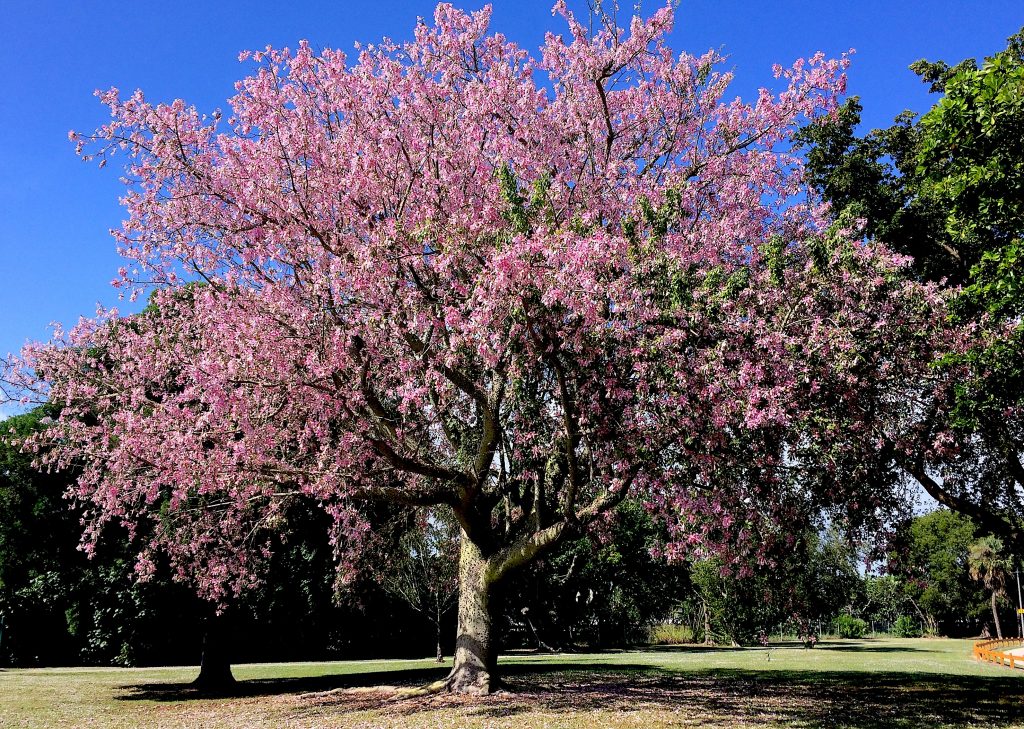
Silk Floss Tree, Dreher Park, West Palm Beach. While flowers of other related species — such as the Kapok Tree — are edible there’s no credible report of eating the flowers of this species. However the seeds of the Ceiba speciosa are edible as is their oil. The flavor resembles coconut. You can read some about the bat-pollenated Kapok Tree here. Photo by Green Deane
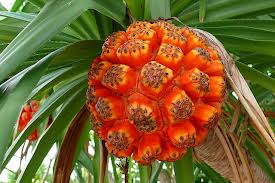
Pandanus Fruit can be “peppery.” Photo by Green Deane
Common plant names can be so misleading. A good example is “Screw Pine.” That’s a common name in English for Pandanus Grass. It has no relations to pines what so ever, not even close. But some species of Pandanus do spiral as they grow which explains part of the name but not the rest. Names aside the fruit is usually edible. They tend to vary a little in calcium oxalate content, from none to a little to a lot. The ones I find in south Florida tend to have none to a little but not enough to stop most from eating them raw. If a little peppery some heating destroys the needle-shaped chemical rendering the fruit edible to those sensitive to it. The Aboriginals made baskets out of the leaves and used the dried stems to carry fire. You can read about Pandanus Grass here.
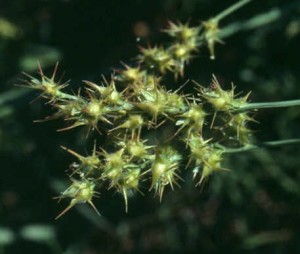
Sand Spurs are edible.
It has been written that there are no toxic native North American grasses. As I have not met them all I don’t know for certain but I have met Sand Spurs and vengeance is mine… While universally called “Sand Spurs” they are actually “Sand Burrs” with a B not an SP. Regardless of what they’re called they are a pain in the grass with each seed covered with several sharp spines. These are usually discovered in feet and ankles and the fingers that extract them. (Small needle-nose pliers in the backpack work wonders.) Sand Spur victims are always amazed to learn they are edible. Nature knows that which is why the nutritious and tasty grain is covered with hostile spines. Clearly grain and spines have to be separated if we are to enjoy them. My favorite method is to use a campfire to burn the spines off and then eat them right off the stem. While one can find them nearly all year round a fresh fall crop is ready to be harvested. To learn more about Sand Spurs click here.
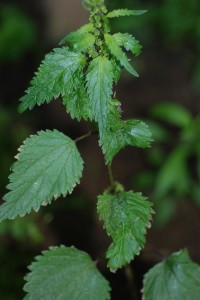
Heartleaf Nettle. Photo by Green Deane
While nettle season is over in northern climates locally they will be coming up in about a month or so and will last into March. While the stinging plant is known as a food and medicine it is also a textile. Ropes, nets even clothes were made out of nettle fibers. Long before silk was known to western peoples the nettle fiber was the soft, glossy textile for high-end clothes. In fact a 2,800 year old example made the news a while ago. The journal Scientific Reports said some ancient fabric scraps found in a Danish grave date back to 940 B.C. to 750 BC. They were found in Voldtofte, a rich Bronze Age burial ground. The fabric was wrapped around the cremated remains of a man in a bronze urn. Using nanophysics researchers also discovered the nettle cloth was not from Denmark but from the Austria area. Also in the urn were two razors. The speculation is the owner died in Austria, was cremated, and then brought back to Denmark for burial. That a long journey when distance was covered by foot. The return of the remains, the nettle cloth and the razors point to his high status. Nettle cloth is not passe by the way. My friend Sunny Savage has a line of clothing made from nettle fibers. You can read about our stinging nettles here.
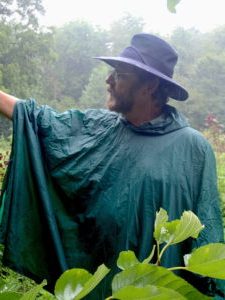
Classes are held rain or shine or cold.
Upcoming foraging classes: If predictions hold true this weekend’s classes will be chilly, at least early on. Dress accordingly. Saturday I’m in Jacksonville and Sunday at Haulover Canal.
Saturday, November 24th Blanchard Park, 10501 Jay Blanchard Trail, Orlando. 9 a.m. to noon. Meet next to the tennis courts by the YMCA building.
Sunday, November 25th, Red Bug Slough Preserve, 5200 Beneva Road, Sarasota, FL, 34233. 9 a.m. to noon. Meet at the entrance of the park.
Saturday, December 1st, Wickham Park: 2500 Parkway Drive, Melbourne, FL 32935-2335. 9 a.m. to noon. Meet at the “dog park” inside the park.
To read more about the foraging classes go here.
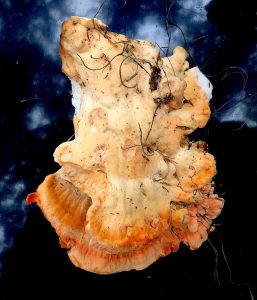
Chicken of the Woods. Photo by Green Deane
When does COW not mean COW? When it’s used for “Chicken of the Woods” a popular, edible fungus. There are within driving distance four species of “Chicken of the Woods” three worth it and one marginal. I have found three of them in Florida and they are in season now. The four species are Laetiperous sulphureus, L. cincinnatus, L. persicinus and L. gilbertsonii var. pallidus… and wouldn’t you know it the first three are fairly easy to identify but the “pallidus” is more tricky and appears to be the more common one locally. (Some day I am going to live where the foraging is uncomplicated.) L. sulphureus is easy: It’s a shelf fungus with yellow pores (why it is called sulphureus) and tends to grow high on a tree where it causes heartwood rot. L. cincinnatus is a more pinkish fungus, grows at the base of the tree causing butt rot or on buried roots. It can be a shelf or a rosette and is called the white “Chicken of the Woods.” I’ve seen L. persicinus at the base of trees and on roots (appearing to be terrestrial.) It’s brown and white and stains easily. It, too, is called a white “Chicken of the Woods” but is the least tasty of the four and has a soft texture. That leaves the long-named L. gilbertonii var. pallidus. Without the “var. pallidus” it’s a west coast-California fungus. But there is a paler version growing along our gulf coast. I think that’s the “chicken” I collected in Gainesville this past weekend during a foraging class (along with some Ringless Honey Mushrooms.) It’s a light tan shelf without yellow pores. It was also growing amongst Spanis Moss, which made cleaning tedious. Usually one cuts off the soft growing edges and cooks.
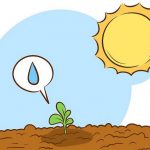 Donations to upgrade EatTheWeeds.com and fund a book have gone well and made it past the half way mark. Thank you to all who have contributed to either via the Go Fund Me link, the PayPal donation link or by writing to Green Deane POB 941793 Maitland FL, 32794. There are many needs left such as expanding the foraging teacher page and the page on monotypic edibles. Several functions were also lost when we transitioned to the new website. There’s always something and such things get more complex and expensive every year.
Donations to upgrade EatTheWeeds.com and fund a book have gone well and made it past the half way mark. Thank you to all who have contributed to either via the Go Fund Me link, the PayPal donation link or by writing to Green Deane POB 941793 Maitland FL, 32794. There are many needs left such as expanding the foraging teacher page and the page on monotypic edibles. Several functions were also lost when we transitioned to the new website. There’s always something and such things get more complex and expensive every year.

Foraging DVDs make a good gift to watch during the lifeless months of winter.
All of Green Deane’s videos are available for free on You Tube. They do have ads on them so every time you watch a Green Deane video I get a quarter of one cent. Four views, one cent. Not exactly a large money-maker but it helps pays for this newsletter. If you want to see the videos without ads and some in slightly better quality you can order the DVD set. It is nine DVDs with 15 videos on each for a total of 135 videos. Many people want their own copy of the videos or they have a slow service and its easier to order then to watch them on-line. The DVDs make a good gift for that forager you know especially on long, cold winter months. Individual DVDs can also be ordered or you can pick and choose. You can order them by clicking on the button on the top right hand side of this page (if your window is open wide enough.) Or you can go here.

Green Deane Forum
Want to identify a plant? Need to identify a plant? Looking for a foraging reference? Maybe you have a UFO, an Unidentified Flowering Object, you want identified. On the Green Deane Forum we — including Green Deane — chat about foraging all year. And it’s not just about warm-weather plants or just North American flora. Many nations share common weeds so there’s a lot to talk about. There’s also more than weeds. The reference section has information for foraging around the world. There are articles on food preservation, and forgotten skills from making bows to fermenting food. Recent topics include: I Finally Found Wapato, Looks like Corn, Weed With Pod At Top, A Mile Walk In The Woods, Chicken of the Woods?, Elderberry Fungus, Spurge Nettle 2018, Does Anybody Know This Berry, and Five-Minute “English” Muffin with Beautyberries. You can join the forum by clicking on the button in the menu line.
This is weekly issue 330.
If you would like to donate to Eat The Weeds please click here. Or you can use my Go Fund Me link, or by writing to Green Deane POB 941793 Maitland FL, 32794

